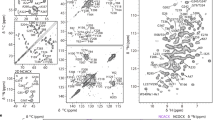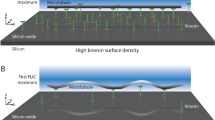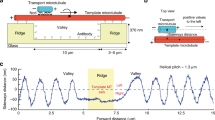Abstract
Kinesin-1 is a dimeric motor protein that moves cargo processively along microtubules. Kinesin motility has been proposed to be driven by the coordinated forward extension of the neck linker (a ∼12-residue peptide) in one motor domain and the rearward positioning of the neck linker in the partner motor domain. To test this model, we have introduced fluorescent dyes selectively into one subunit of the kinesin dimer and performed 'half-molecule' fluorescence resonance energy transfer to measure conformational changes of the neck linker. We show that when kinesin binds with both heads to the microtubule, the neck linkers in the rear and forward heads extend forward and backward, respectively. During ATP-driven motility, the neck linkers switch between these conformational states. These results support the notion that neck linker movements accompany the 'hand-over-hand' motion of the two motor domains.
This is a preview of subscription content, access via your institution
Access options
Subscribe to this journal
Receive 12 print issues and online access
$189.00 per year
only $15.75 per issue
Buy this article
- Purchase on Springer Link
- Instant access to full article PDF
Prices may be subject to local taxes which are calculated during checkout




Similar content being viewed by others
Change history
07 November 2006
In the supplementary information initially published online to accompany this article, the Supplementary Video legends were inadvertently excluded. The error has been corrected online.
References
Vale, R.D. The molecular motor toolbox for intracellular transport. Cell 112, 467–480 (2003).
Hirokawa, N. & Takemura, R. Molecular motors and mechanisms of directional transport in neurons. Nat. Rev. Neurosci. 6, 201–214 (2005).
Svoboda, K., Schmidt, C.F., Schnapp, B.J. & Block, S.M. Direct observation of kinesin stepping by optical trapping interferometry. Nature 365, 721–727 (1993).
Hackney, D.D. Evidence for alternating head catalysis by kinesin during microtubule-stimulated ATP hydrolysis. Proc. Natl. Acad. Sci. USA 91, 6865–6869 (1994).
Vale, R.D. et al. Direct observation of single kinesin molecules moving along microtubules. Nature 380, 451–453 (1996).
Kull, F.J., Sablin, E.P., Lau, R., Fletterick, R.J. & Vale, R.D. Crystal structure of the kinesin motor domain reveals a structural similarity to myosin. Nature 380, 550–555 (1996).
Kikkawa, M. et al. Switch-based mechanism of kinesin motors. Nature 411, 439–445 (2001).
Nitta, R., Kikkawa, M., Okada, Y. & Hirokawa, N. KIF1A alternatively use two loops to bind microtubules. Science 305, 678–683 (2004).
Sack, S. et al. X-ray structure of motor and neck domains from rat brain kinesin. Biochemistry 36, 16155–16165 (1997).
Kozielski, F. et al. The crystal structure of dimeric kinesin and implications for microtubule-dependent motility. Cell 91, 985–994 (1997).
Sindelar, C.V. et al. Two conformations in the human kinesin power stroke defined by X-ray crystallography and EPR spectroscopy. Nat. Struct. Biol. 9, 844–848 (2002).
Rice, S. et al. A structural change in the kinesin motor protein that drives motility. Nature 402, 778–784 (1999).
Vale, R.D. & Milligan, R.A. The way things move: looking under the hood of molecular motor proteins. Science 288, 88–95 (2000).
Yildiz, A., Tomishige, M., Vale, R.D. & Selvin, P.R. Kinesin walks hand-over-hand. Science 303, 676–678 (2004).
Rice, S. et al. Thermodynamic properties of the kinesin neck-region docking to the catalytic core. Biophys. J. 84, 1844–1854 (2003).
Skiniotis, G. et al. Nucleotide-induced conformations in the neck region of dimeric kinesin. EMBO J. 22, 1518–1528 (2003).
Rosenfeld, S.S., Jefferson, G.M. & King, P.H. ATP reorients the neck linker of kinesin in two sequential steps. J. Biol. Chem. 276, 40167–40174 (2001).
Rosenfeld, S.S., Xing, J., Jefferson, G.M., Cheung, H.C. & King, P.H. Measuring kinesin's first step. J. Biol. Chem. 277, 36731–36739 (2002).
Rosenfeld, S.S., Fordyce, P.M., Jefferson, G.M., King, P.H. & Block, S.M. Stepping and stretching: how kinesin uses internal strain to walk processively. J. Biol. Chem. 278, 18550–18556 (2003).
Asenjo, A.B., Krohn, N. & Sosa, H. Configuration of the two kinesin motor domains during ATP hydrolysis. Nat. Struct. Biol. 10, 836–842 (2003).
Asenjo, A.B., Weinberg, Y. & Sosa, H. Nucleotide binding and hydrolysis induces a disorder-order transition in the kinesin neck-linker region. Nat. Struct. Mol. Biol. 13, 648–654 (2006).
Case, R.B., Rice, S., Hart, C.L., Ly, B. & Vale, R.D. Role of the kinesin neck linker and catalytic core in microtubule-based motility. Curr. Biol. 10, 157–160 (2000).
Tomishige, M. & Vale, R.D. Controlling kinesin by reversible disulfide cross-linking: identifying the motility-producing conformational change. J. Cell Biol. 151, 1081–1092 (2000).
Schief, W.R. & Howard, J. Conformational changes during kinesin motility. Curr. Opin. Cell Biol. 13, 19–28 (2001).
Carter, N.J. & Cross, R.A. Kinesin's moonwalk. Curr. Opin. Cell Biol. 18, 61–67 (2006).
Sablin, E.P. & Fletterick, R.J. Coordination between motor domains in processive kinesins. J. Biol. Chem. 279, 15707–15710 (2004).
Kawaguchi, K. & Ishiwata, S. Nucleotide-dependent single- to double-headed binding of kinesin. Science 291, 667–669 (2001).
Skerra, A. & Schmidt, T.G. Applications of a peptide ligand for streptavidin: the Strep-tag. Biomol. Eng. 16, 79–86 (1999).
Tomishige, M., Klopfenstein, D.R. & Vale, R.D. Conversion of Unc104/KIF1A kinesin into a processive motor after dimerization. Science 297, 2263–2267 (2002).
Carter, N.J. & Cross, R.A. Mechanics of the kinesin step. Nature 435, 308–312 (2005).
Suzuki, Y., Yasunaga, T., Ohkura, R., Wakabayashi, T. & Sutoh, K. Swing of the lever arm of a myosin motor at the isomerization and phosphate-release steps. Nature 396, 380–383 (1998).
Shih, W.M., Gryczynski, Z., Lakowicz, J.R. & Spudich, J.A. A FRET-based sensor reveals large ATP hydrolysis-induced conformational changes and three distinct states of the molecular motor myosin. Cell 102, 683–694 (2000).
Forkey, J.N., Quinlan, M.E., Shaw, M.A., Corrie, J.E. & Goldman, Y.E. Three-dimensional structural dynamics of myosin V by single-molecule fluorescence polarization. Nature 422, 399–404 (2003).
Houdusse, A., Kalabokis, V.N., Himmel, D., Szent-Györgyi, A.G. & Cohen, C. Atomic structure of scallop myosin subfragment S1 complexed with MgADP: a novel conformation of the myosin head. Cell 97, 459–470 (1999).
Turner, J. et al. Crystal structure of the mitotic spindle kinesin Eg5 reveals a novel conformation of the neck-linker. J. Biol. Chem. 276, 25496–25502 (2001).
Kinosita, K., Jr. et al. How two-foot molecular motors may walk. Adv. Exp. Med. Biol. 565, 205–219 (2005).
Hackney, D.D. The tethered motor domain of a kinesin-microtubule complex catalyzes reversible synthesis of bound ATP. Proc. Natl. Acad. Sci. USA 102, 18338–18343 (2005).
Hua, W., Chung, J. & Gelles, J. Distinguishing inchworm and hand-over-hand processive kinesin movement by neck rotation measurements. Science 295, 844–848 (2002).
Asbury, C.L., Fehr, A.N. & Block, S.M. Kinesin moves by an asymmetric hand-over-hand mechanism. Science 302, 2130–2134 (2003).
Kaseda, K., Higuchi, H. & Hirose, K. Alternate fast and slow stepping of a heterodimeric kinesin molecule. Nat. Cell Biol. 5, 1079–1082 (2003).
Higuchi, H., Bronner, C.E., Park, H.-W. & Endow, S.A. Rapid double 8-nm steps by a kinesin mutant. EMBO J. 23, 2993–2999 (2004).
Ishii, Y., Yoshida, T., Funatsu, T., Wazawa, T. & Yanagida, T. Fluorescence resonance energy transfer between single fluorophores attached to a coiled-coil protein in aqueous solution. Chem. Phys. 247, 163–173 (1999).
Gelles, J., Schnapp, B.J. & Sheetz, M.P. Tracking kinesin-driven movements with nanometre-scale precision. Nature 331, 450–453 (1988).
Acknowledgements
We thank K. Thorn for development of the initial version of the microscope system and for discussions, and U. Wiedemann for support in cloning and protein purification. M.T. is supported by grants from the Mitsubishi Foundation, Asahi Glass Foundation, Sumitomo Foundation and Inamori Foundation and by Grants-in-Aid for Scientific Research on Priority Areas. R.D.V. is supported by grants from the Howard Hughes Medical Institute and the US National Institutes of Health.
Author information
Authors and Affiliations
Contributions
M.T. and R.D.V. conceived and designed the experiments. M.T. performed the experiments and data analysis. N.S. contributed to microscope construction and programming. R.D.V. and M.T. discussed the results and wrote the manuscript.
Corresponding authors
Ethics declarations
Competing interests
The authors declare no competing financial interests.
Supplementary information
Supplementary Fig. 1
Effects of dye-labeling on processivity. (PDF 196 kb)
Supplementary Fig. 2
Histograms for monomer FRET. (PDF 123 kb)
Supplementary Fig. 3
Dynamic FRET traces for neck linker. (PDF 197 kb)
Supplementary Fig. 4
Histograms of dwell time between transitions. (PDF 73 kb)
Supplementary Fig. 5
Dynamic FRET traces for controls. (PDF 467 kb)
Supplementary Video 1
Photobleaching events of 342:342 heterodimer kinesin molecules labeled with Cy3 (donor) and Cy5 (acceptor) attached to an axoneme in the presence of 1 M ATP (excited at 514 nm). The sequence shows a molecule that initially has high FRET, and then suddenly the acceptor dye disappears with an accompanying single step recovery of donor fluorescence. This is a clear indication for single dye pair FRET. The donor fluorescence subsequently disappears in a single step, presumably due to photobleaching or detachment from the microtubule. Later, another dual labeled molecule binds to the axoneme and shows similar photobleaching process. Left half and right half of the images show donor and acceptor channels, respectively, which are projected side-by-side on the ICCD camera simultaneously. 1/2 real time. Scale bar, 2 µm. (MOV 1198 kb)
Supplementary Video 2
Single molecule FRET observation of 215-342 heterodimer kinesin moving along an axoneme in the presence of saturating ATP (1 mM). This video shows three fluorescence spots showing FRET moving processively along an axoneme. The axoneme lies approximately vertical in the image with its plus end pointing upwards. No apparent anticorrelated donor and acceptor intensity change is observed. 1/2 real time. Scale bar, 2 µm. (MOV 1597 kb)
Supplementary Video 3
Single molecule FRET observations of 215-342 heterodimer kinesin moving slowly along axonemes in the presence of low ATP (1 M). Video 3 and 4 represent the panels shown in Figure 3a, (far left and far right, respectively). Both of the spots move slowly upwards. Anti-correlated donor and acceptor intensity changes are observed. 1/2 real time. Scale bar, 2 µm. (MOV 1061 kb)
Supplementary Video 4
Single molecule FRET observations of 215-342 heterodimer kinesin moving slowly along axonemes in the presence of low ATP (1 M). Video 3 and 4 represent the panels shown in Figure 3a, (far left and far right, respectively). Both of the spots move slowly upwards. Anti-correlated donor and acceptor intensity changes are observed. 1/2 real time. Scale bar, 2 µm. (MOV 1095 kb)
Rights and permissions
About this article
Cite this article
Tomishige, M., Stuurman, N. & Vale, R. Single-molecule observations of neck linker conformational changes in the kinesin motor protein. Nat Struct Mol Biol 13, 887–894 (2006). https://doi.org/10.1038/nsmb1151
Received:
Accepted:
Published:
Issue Date:
DOI: https://doi.org/10.1038/nsmb1151
This article is cited by
-
Magic-angle-spinning NMR structure of the kinesin-1 motor domain assembled with microtubules reveals the elusive neck linker orientation
Nature Communications (2022)
-
Step Sizes and Rate Constants of Single-headed Cytoplasmic Dynein Measured with Optical Tweezers
Scientific Reports (2018)
-
Crystal structure of Zen4 in the apo state reveals a missing conformation of kinesin
Nature Communications (2017)
-
A programmable DNA origami nanospring that reveals force-induced adjacent binding of myosin VI heads
Nature Communications (2016)
-
Direct observation of intermediate states during the stepping motion of kinesin-1
Nature Chemical Biology (2016)



